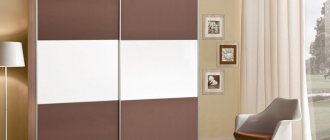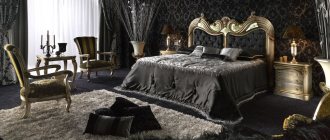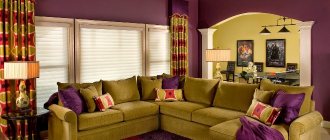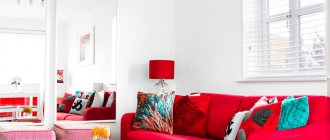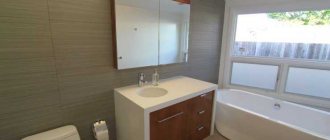The purple color in the living room interior gives the room aristocracy and luxury
, filling every corner with a magical aura.
The main room in the apartment is given special sophistication by the use of various shades of color, in particular plum, lavender, lilac and others, no less spectacular. Many variations of their combination allow you to decorate the interior in any style in an original and beautiful way. Each shade of purple has its own character and characteristics
, which are taken into account when creating the design of the room.
Advantages and disadvantages of a living room in lilac color
It is difficult to decorate a living room in lilac color without knowing about its advantages and disadvantages. We invite you to find out what the strengths and weaknesses of one of the most mysterious tones of the palette are.
Pros:
- Positive effect on the psyche. The lilac living room has a therapeutic effect - it calms, relieves stress and anxiety, improves mood. Being with the whole family in a lavender living room is a real holiday for the soul.
- Good compatibility. A large palette makes it possible to use color in different interior styles.
- Suitable for small living rooms. Lilac shades of light and medium saturation do not visually reduce the space, so they can be used in small rooms.
- Harmonizes with gloss and glass. Lavender tones look harmonious surrounded by glass and gloss. Not all shades of the palette can boast of this quality.
Minuses:
- Originality of color. Not everyone will like the increased tenderness and romance of lilac. Lavender color can quickly become boring due to its non-standard nature.
- Difficulties in choosing a color pair. Lilac does not go equally well with all colors. There are always nuances of choosing a color pair that you need to know about.
- Not suitable for all rooms. If the room faces north, then lilac will not be the best option. It will look too cold here. After all, one of its components is a cool blue undertone.
Purple living rooms
An amethyst half-tone living room will look mysterious and elegant if it is complemented with a spectacular lighting design with neon bulbs and LED lamps on the ceiling.
And it is best to decorate it with crystal accessories and tall, narrow vases.
A lavender-colored living room will look fashionable and stylish, especially if you add gold or olive-colored items. An elegant addition to such an interior would be a crystal-shaped aroma lamp with lavender essential oil.
A living room in grape shades will look positive and solemn if you add glass flowerpots and a crystal chandelier to it.
A living room in purple colors goes well with a noble shade of gray.
Green objects will enliven a purple living room, especially if you make a white glossy stretch ceiling.
The living room will look gentle if you dilute it with pink or crimson color, and complement the interior with a chandelier with a chrome base and crystal-shaped lampshades.
Features and shades of color
The peculiarity of color is that it is complex in terms of compatibility. When choosing a color pair you need to be careful. Lilac is sensitive to other shades and reacts to them differently. Each color changes the character of the lavender tones:
- Brown. Gives brightness, shades depth.
- Blue. “Cools” light purple shades, making them pale.
- Yellow. Almost discolors the light lilac color scheme. But in combination with bright tones it gives them richness and cheerfulness.
- Blue. It eats up the fragility of the lilac tone, making it indistinct and inexpressive. The only option is to combine it with a blue color that has a marine undertone: turquoise, aquamarine, topaz, azure.
- White and beige. In combination with lilac, the result is a delicate, subtle, graceful and fresh composition. The same effect is achieved by light gray tones in combination with shades of light orchid.
Lilac has many different shades. The color expert alone, the Pantone Institute, has about 200 of them. All lilac tones can be divided into several categories:
- Light: lavender, lupine, thistle, white-lilac and light orchid shades.
- Medium: light violet and purple tones, dark lavender, powdery amethyst, beige-lilac, violet, cyclamen.
- Bright: rich purple, crocus, currant tones, magenta.
Lilac is the result of the fusion of two colors: blue and red. If there is more red in the shade, then it becomes warm, bright, and goes into the pink-crimson range. When the blue undertone dominates, the color gains depth. It takes on a cooler character and fascinates with mystery.
Lilac combines two opposite colors: cold and warm. The pink undertone warms, while the cool blue undertone soothes. Because of this, the color is recommended as calming, relaxing, and suitable for relaxation.
Stylish bedroom
To create your dream bedroom, you need to think in advance about the mood it should evoke. Stronger colors, such as eggplant and plum, stimulate the senses and arouse attention. They can be combined with extravagant fabrics - velvet, velor, jacquard. At the other end of the spectrum are more soothing and delicate colors - lilac, lavender, puce. It muffles strong emotions and helps you relax. Using the table, you can determine with utmost precision how the purple color in the interior will set the mood and how other colors will emphasize or subdue its 17 shades.
Table 1. Combining different shades of purple with other colors when creating a bedroom decor.
| How to combine Shade | Perfect | Fine | Badly | ||
| Purple-red | Green, turquoise | Light orange, mint green | Yellow, brown, beige | ||
| Plum | Orange, white | Green, ultramarine | Indigo, light green | ||
| Orchid | Bright crimson, ash | Red | Beige, brown, plum | ||
| Bright purple | Green, blue, brown | Black, ash | White | ||
| Mauve | Silver, beige, terracotta | Orange, crimson, red | Indigo | ||
| Violet | Grey, yellow | Turquoise, | Green, brown | ||
| Eggplant | Black, milky white | Charcoal, pale yellow | Beige | ||
| Amethyst | Turquoise, pale pink | Lemon, red | Crimson | ||
| Heliotrope | Blue, gray, scarlet | Raspberry red, mint color | Fuchsia color | ||
| Indigo | Ultramarine, beige | Brown, white, milky | Dark green, dirty yellow | ||
| Fuchsia | Grey, tan, brown | Lime, mint green, pale yellow | White, black, indigo | ||
| Thistle | Red, yellow, dark blue | Orange, terracotta, fresh greens | Beige, pink, bright purple | ||
| Lilac (lilac) | Yellow orange | Olive, pink | Mocha, lime | ||
| Lavender | Dark brown, | Pale pink, black, mocha | Orange | ||
| Carnation | Black, purple | Light blue, mint | Blueberry, blue | ||
| Magenta (purple) | Light brown, pale yellow | White, scarlet | Beige, ash, charcoal | ||
| Pyusovy | Dark blue, brown | Brown | White, green | ||
Purple color in the interior of the room
Kitchen design in purple
Purple color in the interior
See alsoFuturism in the interior: secrets, accents, layout
Characteristics and perception
Psychologists say that lilac color is chosen by creative, dreamy and optimistic people. They have their head in the clouds a little, like to become completely immersed in dreams and often focus on their inner world. The effect that color gives is as multifaceted as its unusual character.
A living room in lilac tones evokes a whole kaleidoscope of visual associations:
- Positive. An interior in lilac shades always encourages optimism and positive emotions.
- Spring. When looking at lavender and cyclamen tones, a direct association arises with spring and blooming gardens.
- Hope. A room decorated in this color has a positive effect on the psyche, calms you down and gives you hope for the best.
- Inspiration. Color seems to take you away from reality, allows you to dream, gives inspiration, and encourages creativity.
- Lightness and freshness. Light, powdery shades especially often give this feeling.
- Elegance. Charm and sophistication are the main attributes of color. It is elegant, sophisticated, a little mysterious, but there are no heavy, oppressive notes in it.
The lilac palette was popular back in the 17th century. The Baroque style reigned in the design of the premises at that time. The color fits well into the lush, aristocratic, rich and complex style.
Today, lilac shades are in demand in interiors such as: retro, Provence, vintage, minimalist, modern and many others.
It is better not to oversaturate the living room with bright lilac shades. Being constantly in such a color environment, a person will experience excessive emotional uplift, which can be replaced by a feeling of anxiety. An abundance of light lavender shades, on the contrary, will be too relaxing, distracting, and make it difficult to concentrate.
Combination with green
It is very rare to see a living room in lilac in combination with green. For most people, this color is simply extravagant. This combination is quite interesting. Read here: Living room furniture - 100 photos of new items from the catalog
To balance the effect more, we recommend taking into account some points.
To begin with, it is important to stick to a combination of light and dark. For example, it is worth taking a light green shade in combination with a dark lilac, or vice versa. In this case, the main task is to make a light background, everything else will be darker.
In accordance with another rule, it is important to arrange excellent lighting. When choosing a dark color scheme, it should be neutralized with lighting, or with the help of white accents. In this case, the interior will be livelier and more beautiful.
And the most important thing in design is that the room is large, otherwise it will look small and gloomy.
What colors does it go with?
Lilac is not as versatile as gray or beige. It requires a meticulous approach, especially when it comes to combining it with other tones. The best combinations of lavender and cyclamen shades are obtained if you combine them with the following colors:
- Mustard
Goes well with dark lilac. The pair turns out to be natural, natural, discreet and sophisticated. As other accents, you can add white, add accents with dove and dark purple strokes. A thick, dark blue-green touch will add originality.
- Beige
The color itself is neutral; it is used as a base to reveal all the hidden nuances of another shade. Beige will add elegance and will not overshadow even the lightest shades of lavender.
- Grey
The neutral nature of gray will help highlight the best aspects of lilac. Gray will not strive to come to the fore. Despite the coldish nature of the tandem, it looks elegant, it combines intelligence and a creative note.
- Amber
Brownish-yellow tones fit well into the lilac color scheme of the interior. The warmth, richness and softness of the honey palette harmoniously complements the gentle, but slightly restive character of lilac.
- Turquoise
Interior designers have recently paid attention to this color pair. Interesting stylistic solutions have emerged. The design that combines pastel tones of both colors looks best. You can add a little light brown, light gray colors to them. Bright blackberry or aquamarine accents look good.
- Green
The most natural combination that is found in abundance in nature. Lush foliage of irises, blooming lavender, May bushes of Persian lilac - all this is a small part of the examples of a harmonious duet. But, according to designers, not all green options are suitable for this purpose. For example, too dark colors will make the interior gloomy. The best choice is shades of young greens that have a yellowish undertone. You can dilute the color pair with white, beige or cappuccino.
- Violet
Lilac is a shade of purple. Therefore, their combination always looks harmonious. The monochrome composition turns out stylish. It is suitable for different interior options: art deco, retro styles, modern.
Accessories
For those who want to organize a purple living room interior, but do not want the design to look too bright, choosing the appropriate accessories is important. Popular accessories in the living room:
- textiles (pillows, blankets, curtains, napkins);
- carpet;
- lamps, chandeliers, floor lamps;
- candles;
- flower pots, flower stands;
- vases;
- coffee table.
Purple living room design - photo
This way the interior takes on an original character. Purple accessories are a great choice for those who are afraid of this shade on the walls. A living room in white and purple tones has an advantage: when the bright shade gets boring or starts to irritate you, you can easily replace the lilac accessories with others.
Delicate shades of lavender combine harmoniously with white details and vintage-style furniture. Lavender notes can be introduced by soft fabric, warm upholstery, shiny pillows.
Purple is a very beautiful color with a rich palette, which in a certain version will look very expensive and luxurious.
Dark purple is a great option for decorating a living room in a classic style. Brighter colors can be used for modern living rooms. Read more about the living room interior in purple tones in this article.
Lilac in different interior styles
Lilac color can be used in various interior solutions. But it will be most successful in styles such as:
- Provence. The lavender color is simply created for the style of the French countryside Provence. He is dreamy and romantic, touching and somewhat naive. It has retro notes, lightness, airiness and harmony with nature. To create a spectacular, warm and cozy interior, you can add ivory, brown and grass green to lavender tones.
- Classic. To create a classic style, delicate shades of lavender in combination with white are best suited. Gold or silver accessories are added to this exquisite tandem.
- Ethno. There are many shades of brown in ethnic style. It goes well with lilac tones. It is advisable to add natural materials to the decor of the lilac eco-living room: stone, wood, ceramics.
- Art Deco. Graphics, effectiveness and originality are the main features of the style. Wallpaper of rich purple color and decorative decorations of a golden or brown hue are ideal for it. To prevent the room from looking too gloomy and closed, you can add white or off-white curtains.
- Modern. In standard modern style, natural colors with a hint of ash or sand predominate. Lavender can be used here only for placing small accents, for example: lamps, figurines, vases, curtains. Moreover, it is better to take the color in equal proportions with black.
- High tech. Despite its dreamy and romantic character, lilac easily fits into modern, stylish, technological and strict high-tech. Here an unusually harmonious compatibility of color with metal, chrome surfaces and glass is evident. It is advisable to use deep shades: amethyst, dark orchid, blue-lilac, purple.
Psychology of purple
When choosing shades for the interior, it is worth analyzing your own preferences. An easy way to find colors that make a person feel good is to look at their clothing. If you don’t have rich orange-colored clothes in your wardrobe, then orange in your interior will be annoying. For inspiration, you should flip through the pages of glossy magazines and look at the offers of websites dedicated to interior design. This is an easy method to choose the perfect wall color for your living room. The shade of the walls should depend on the furniture and equipment that is already there and that is planned to be installed in the updated living room.
The other side of the issue is related to the psychology of color - it has been scientifically proven that color tone specifically affects mood and behavior. Bright, rich colors have a huge impact on the audience.
Purple has some properties:
- Great for stimulating the brain;
- stimulates the nervous system;
- soft shade has a positive effect on concentration;
- light shades are soothing; beautiful interiors with them seem to be a haven of peace and tranquility.
Purple is a great color for a living room with a bookcase and for offices.
Photo. A glamorous interior with a purple wall and lampshades is made warm and cozy by wooden floors and white wooden furniture.
Rules and ideas for decorating a living room in lilac color
Lilac shades can make the interior airy, feminine and romantic, or strict, serious, masculine. You can decorate a nursery, kitchen, bedroom, hallway and even a bathroom in this color. The main thing is to skillfully select the tone, be able to beat them and follow the rules for using lilac color:
- Maintain balance. It is important to maintain the ratio of light and dark tones. For example, if the walls are light, then the furniture should be in rich colors, otherwise it will blend in with the surroundings. And, conversely, it is better to select furniture and textiles in light shades for dark walls. Textiles must be made in diluted colors.
- Monitor the temperature. Any color has warm and cool shades. Lilac is no exception. In the interior you need to correctly combine warm and cold tones. If they are not balanced, the living room will turn out to be too “cooled” or “overheated”. The rule is simple: the main color is cold, which means you need to add a warm tone to it. If the basic solution is warm, then it is diluted with cold nuances.
- Choose the perfect color combination. As already mentioned, the ideal pair for lilac would be: the color of natural wood, olive, grass green, beige, gray, khaki, powder pink. It is advisable to choose pastel shades of these colors.
The first purple strokes. How to find your option?
To understand how the color purple can decorate or change the decor of a home beyond recognition, you need to decide what functions the space will perform? For example, for a schoolchild or student’s office and nursery, you need to select calm, subdued options. They should activate thinking and not suppress at the same time. These shades are: prune, mulberry and basil. Lighter colors (light pink, lilac, iris) will incline the nervous system to sleep.
When choosing colors for a bedroom, everything down to the smallest detail should excite (unless the apartment belongs to a single old man), but just enough so that the walls do not “crush.” If the owner or hostess of the room is an eccentric person, then eggplant, dark purple or plum are ideal for them. For calm, patient and sensitive individuals, purple and orchid can transform the bedroom.
The combination of white and purple in the kitchen interior
Chic room design with purple sofa
Purple color in the living room interior
See also: “Mint” color, photo.
Design of main surfaces
- The living room facing south should be decorated with cooler lavender shades. To enhance the feeling of coolness, you can add tones of blue and cyan. The heat in summer will not be felt so much.
- It is easy to visually “warm” a hall with access to the north. To do this, just add a pink tone from a warm range to the main color.
- Enlarge a small room with light shades. To do this, the walls and ceiling are painted light lilac. Moreover, the ceiling should be 1–2 shades lighter. This way it will become visually taller, and the room will acquire volume and airiness.
- By mixing other colors with lilac, you can achieve interesting visual effects. For example, if you add dark lilac, violet, and blackberry accents, the design will turn out to be sophisticated and solemn. By adding light blue tones, you can create a feeling of palace luxury or glamor. And the gray color will give the lilac room an eclectic feel.
The living room can be completely covered with lilac wallpaper. In this case, it is advisable to highlight some area in the room with a deeper shade, and decorate the rest of the space in light colors. But it’s better not to make the renovation completely monochrome. The living room will look much more impressive if you add other shades to the lilac. The easiest way is to include beige or gray in the design.
Furniture
Lilac is not the most common interior design option. The choice of this color speaks of the originality of the owner of the house and his creative streak. When choosing furniture for a room, it is important to create a game of contrasts: if the walls are light, then furniture in deep tones will suit them and, conversely, a dark room should be furnished with light furniture. You can choose lilac pillows for a beige sofa. This combination will be especially successful if you hang curtains in purple shades on the windows.
Textiles and carpets
Textiles can be dark or light, it all depends on the basic tone of the room. You can complement lilac curtains with transparent, weightless tulle in a white or milky shade. But it is better to avoid too dark purple shades of curtains. They will create a feeling of heaviness.
There are several options for choosing a carpet in a lilac room:
- Tone on tone. The carpet completely matches the main shade of the room's furnishings. The result is a calm, harmonious interior.
- Contrast. The carpet stands out noticeably against the general background. This option is especially relevant if the living room needs to be divided into zones by color. Often this need arises in one-room apartments or studios.
- To match the color of the vertical. We are talking about when the shade of the carpet is matched to the color of the curtains and/or walls.
- Under color spots. If the room already has color accents, then you can match the tone of the carpet with them. For example, match an orange floor lamp and panel with an orange rug. And in the general atmosphere, lavender color will predominate.
The color of the carpet may well become an independent color accent in the room. But if you still get the feeling that it stands out from the overall picture, then it can always be supported by details of the same color.
Decor and accessories
The decor is selected depending on the style of the living room. But it is necessary to remember that lavender shades combine well with complex draperies, gloss, glass, crystal, metal texture, gilding, elegant figurines, and candlesticks. It is not advisable to combine the shade with rough wood, leather texture and stone.
Lighting Features
Lilac shades get along well with both dim and bright lighting. Dimmed light will create a cozy, intimate atmosphere. But it is better to combine it with light shades. If the room has a dark design, then it is more advisable to use brighter lighting.
The choice of lamp depends on the interior style of the lilac room:
- Classic. For a classic style, a crystal chandelier is suitable. Porcelain or ceramic lampshades in the form of flowers, leaves, bowls, a chandelier or a lamp in the form of a candlestick would also be appropriate.
- Provence. In a Provence-style living room, modest but elegant lamps should be laconic, without monograms or curlicues. Naturalness and simplicity are the main features of this style.
- Modern. Natural lighting is important in modernity. Large windows with plenty of daylight are not uncommon. Artificial lighting is represented by simple lamps in a forged frame, pendant lamps, wall sconces, and floor lamps. The only condition is that they must be simple, without elaborate elements.
- Ethno. Table lamps and floor lamps made of rattan, forged ceiling lamps, lamps with Turkish-style mosaics, and carved torch lamps are best suited for ethnic style.
- High tech. Almost complete absence of decor, laconic geometric shapes in the style of constructivism and cubism, shiny chrome, glossy surfaces with a cold metallic sheen - this is what high-tech style lamps should be.
- Art Deco. Lighting in a lilac Art Deco room should come from above. Floor lamps and sconces can only be used as additional light sources. The most win-win option is a pretentious chandelier with luxurious decor: gilded plates, horns, crystal balls.
The lilac living room always attracts attention with its originality. It stands out from standard concepts about the interior of a living room, and thereby becomes unique, unlike the others. If you prefer non-trivial solutions, then a lilac living room is the best way to show your individuality.
Gold, silver, purple... Combination with other colors
In order for the atmosphere in the house to bring only positive emotions, it is necessary to correctly combine tones. You can decorate different rooms using violet as a basis in the following variations.
See also Lavender color in the interior, photo.
Fresh plum
Basic tones: plum, lime green, pale cobalt, snow white. This range will ideally transform a bedroom or living room, the windows of which face the south or south-east. To decorate the space, it is better to use a white or pale pistachio color, while one of the walls can be made a bright accent in the “lime green” option.
Bedroom design in purple
Combination of white and purple colors in the interior
See alsoPurple sofa in the interior
Lavender in the snow
Shades: white linen, snow white, fuchsia, French lavender, eggplant. In this range you can transform the kitchen, dining room and even the children's room. This is one of the most reliable color combinations and is a sign of the Provence style. The walls in such an environment should be painted with creamy white paint or use ecru, pale pink lavender.
See also: Chic interior - what should it be like?
Retro cottage
Dominant colors: olive green, pale gold, garnet red, putty, plum and azure. The interior style typical of the 40s of the 20th century can be created in modern conditions, using reddish tones. The walls in this version can be painted cream, pale blue or light gray.
Dark purple color in the interior
Purple color in the interior of the house
Light room design in purple
See alsoMarsala color in the interior: tips, advantages, photos
"Bottle of Claret"
Paints used: dusty turquoise, burgundy, rose sulfur, buttermilk, charcoal and teal (blue green). This combination “cools” the room. The best color for the walls is off-white.
See alsoBlack and white interior: features, photos
Magenta
Paints for creating a bright, challenging interior: charcoal, ice blue, mustard, purple, bright olive. To prevent such a design from seeming vulgar, bright “hot” indigo should be complemented with a delicate purple tint. The best options for walls are white, light gray, field mustard.
See alsoColor solutions in the interior: tips, photos
Picnic by the lake
Shades used: foggy sky, madder rose, bright olive green, fiery orange, dusty plum. The secret of the similarity of the interior with the pretty landscapes of lakes is this: rich shades look harmonious against the backdrop of light neutrals, woody tones and leafy greens. In this style you can decorate a balcony, a spacious loggia or veranda. Current backgrounds are pure white, pale gray, hazy blue.
In addition to remodeling walls, ceilings, floors and doors, purple color in the interior is used for decoration - carpets, curtains, pillows and other accessories. The success of the setting will be ensured by using one paint in three details. For example, walls, pillows and vases.
Room design in dark purple
Bright purple color in the interior of the room
See also African style in the interior: features, photos
Distinctive features of the purple color scheme
Purple color was born from the combination of red and blue. Both basic colors have a pronounced and definite character - red is hot, daring, aggressive, while blue feels cold, aloof, and calm. The predominance of one of the colors allows you to create a lot of different shades of purple, differing in the degree of impact and the general appearance of the interior.
The main features of purple tones in design:
Bright, dark shades stimulate creative thoughts and awaken creativity. Discreet light colors soothe, give peace, set the mood for rest, relaxation, and sleep. It is important to observe moderation in the use of color - an excess of purple tone looks and acts irritating. Suitable for bedrooms for people of any gender, children, and matrimonial rooms. The main task is to select a shade.. Rich bright colors make the room brutal and give masculine features
Delicate shades of lilac and lavender are suitable for girls’ and children’s rooms. The mystery of the purple range is determined by the combination of colors that have opposite effects - warm and cold. Design in this style suits emotional people who know their needs and have pronounced taste preferences.
Rich bright colors make the room brutal and impart masculine features. Delicate shades of lilac and lavender are suitable for girls’ and children’s rooms. The mystery of the purple range is determined by the combination of colors that have opposite effects - warm and cold. Design in this style suits emotional people who know their needs and have pronounced taste preferences.
Purple tones were chosen by the nobility, the highest clergy, this is the color of sorcerers and magicians. In hot countries, this color was used in the interior of bedrooms to give the room at least the appearance of coolness. Different tones fit harmoniously into most decor styles. A bedroom in any shade of color will look luxurious, status, and stylish.
